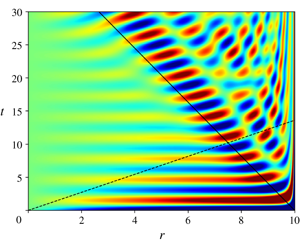Published online by Cambridge University Press: 06 February 2020

In a previous paper, Oruba et al. (J. Fluid Mech., vol. 818, 2017, pp. 205–240) considered the ‘primary’ quasi-steady geostrophic (QG) motion of a constant density fluid of viscosity  $\unicode[STIX]{x1D708}$ that occurs during linear spin-down in a cylindrical container of radius
$\unicode[STIX]{x1D708}$ that occurs during linear spin-down in a cylindrical container of radius  $r^{\dagger }=L$ and height
$r^{\dagger }=L$ and height  $z^{\dagger }=H$, rotating rapidly (angular velocity
$z^{\dagger }=H$, rotating rapidly (angular velocity  $\unicode[STIX]{x1D6FA}$) about its axis of symmetry subject to mixed rigid and stress-free boundary conditions for the case
$\unicode[STIX]{x1D6FA}$) about its axis of symmetry subject to mixed rigid and stress-free boundary conditions for the case  $L=H$. Here, Direct numerical simulation at large
$L=H$. Here, Direct numerical simulation at large  $L=10H$ and Ekman numbers
$L=10H$ and Ekman numbers  $E=\unicode[STIX]{x1D708}/H^{2}\unicode[STIX]{x1D6FA}$ in the range
$E=\unicode[STIX]{x1D708}/H^{2}\unicode[STIX]{x1D6FA}$ in the range  $=10^{-3}{-}10^{-7}$ reveals inertial wave activity on the spin-down time scale
$=10^{-3}{-}10^{-7}$ reveals inertial wave activity on the spin-down time scale  $E^{-1/2}\unicode[STIX]{x1D6FA}^{-1}$. Our analytic study, based on
$E^{-1/2}\unicode[STIX]{x1D6FA}^{-1}$. Our analytic study, based on  $E\ll 1$, builds on the results of Greenspan & Howard (J. Fluid Mech., vol. 17, 1963, pp. 385–404) for an infinite plane layer
$E\ll 1$, builds on the results of Greenspan & Howard (J. Fluid Mech., vol. 17, 1963, pp. 385–404) for an infinite plane layer  $L\rightarrow \infty$. In addition to QG spin-down, they identify a ‘secondary’ set of quasi-maximum frequency
$L\rightarrow \infty$. In addition to QG spin-down, they identify a ‘secondary’ set of quasi-maximum frequency  $\unicode[STIX]{x1D714}^{\dagger }\rightarrow 2\unicode[STIX]{x1D6FA}$ (MF) inertial waves, which is a manifestation of the transient Ekman layer, decaying algebraically
$\unicode[STIX]{x1D714}^{\dagger }\rightarrow 2\unicode[STIX]{x1D6FA}$ (MF) inertial waves, which is a manifestation of the transient Ekman layer, decaying algebraically  $\propto 1/\surd \,t^{\dagger }$. Here, we acknowledge that the blocking of the meridional parts of both the primary-QG and the secondary-MF spin-down flows by the lateral boundary
$\propto 1/\surd \,t^{\dagger }$. Here, we acknowledge that the blocking of the meridional parts of both the primary-QG and the secondary-MF spin-down flows by the lateral boundary  $r^{\dagger }=L$ provides a trigger for other inertial waves. As we only investigate the response to the primary QG-trigger, we call the model ‘reduced’ and for that only inertial waves with frequencies
$r^{\dagger }=L$ provides a trigger for other inertial waves. As we only investigate the response to the primary QG-trigger, we call the model ‘reduced’ and for that only inertial waves with frequencies  $\unicode[STIX]{x1D714}^{\dagger }<2\unicode[STIX]{x1D6FA}$ are triggered. We explain the ensuing organised inertial wave structure via an analytic study of the thin disc limit
$\unicode[STIX]{x1D714}^{\dagger }<2\unicode[STIX]{x1D6FA}$ are triggered. We explain the ensuing organised inertial wave structure via an analytic study of the thin disc limit  $L\gg H$ restricted to the region
$L\gg H$ restricted to the region  $L-r^{\dagger }=O(H)$ far from the axis, where we make a Cartesian approximation of the cylindrical geometry. Other than identifying a small scale fan structure emanating from the corner
$L-r^{\dagger }=O(H)$ far from the axis, where we make a Cartesian approximation of the cylindrical geometry. Other than identifying a small scale fan structure emanating from the corner  $[r^{\dagger },z^{\dagger }]=[L,0]$, we show that inertial waves, on the gap length scale
$[r^{\dagger },z^{\dagger }]=[L,0]$, we show that inertial waves, on the gap length scale  $H$, radiated (wave energy flux) away from the outer boundary
$H$, radiated (wave energy flux) away from the outer boundary  $r^{\dagger }=L$ (but propagating with a phase velocity towards it) reach a distance determined by the mode with the fastest group velocity.
$r^{\dagger }=L$ (but propagating with a phase velocity towards it) reach a distance determined by the mode with the fastest group velocity.
{\it Movie 1}\\ This movie shows the $\chi$-contours in the case $\Ek=10^{-3}$, as a function of time: (a) the direct numerical simulations $\Ek^{-1/2}\chi_{\tDNS}$ (colour scale from -0.3 to 0.3); (b) the filtered DNS, with the geostrophic flow substracted $\chi_{\tFNS}$ (colour scale from -0.1 to 0.1); (c) the analytic solutions $\chi_{\tIW}$ (colour scale from -0.1 to 0.1).\\
{\it Movie 2}\\ This movie shows the $v$-contours in the case $\Ek=10^{-3}$, as a function of time: (a) the direct numerical simulations $\Ek^{-1/2}v_{\tDNS}$ (colour scale from -30 to 30); (b) the filtered DNS, with the geostrophic flow substracted $v_{\tFNS}$ (colour scale from -0.5 to 0.5); (c) the analytic solutions $v_{\tIW}$ (colour scale from -0.5 to 0.5).\\
{\it Movie 3}\\ This movie shows the $\chi$-contours in the case $\Ek=10^{-5}$, as a function of time: (a) the direct numerical simulations $\Ek^{-1/2}\chi_{\tDNS}$ (colour scale from -0.3 to 0.3); (b) the filtered DNS, with the geostrophic flow substracted $\chi_{\tFNS}$ (colour scale from -0.1 to 0.1); (c) the analytic solutions $\chi_{\tIW}$ (colour scale from -0.1 to 0.1).\\
{\it Movie 4}\\ This movie shows the $v$-contours in the case $\Ek=10^{-5}$, as a function of time: (a) the direct numerical simulations $\Ek^{-1/2}v_{\tDNS}$ (colour scale from -30 to 30); (b) the filtered DNS, with the geostrophic flow substracted $v_{\tFNS}$ (colour scale from -0.5 to 0.5); (c) the analytic solutions $v_{\tIW}$ (colour scale from -0.5 to 0.5).\\
{\it Movie 5}\\ This movie shows the $\chi$-contours in the case $\Ek=10^{-7}$, as a function of time: (a) the direct numerical simulations $\Ek^{-1/2}\chi_{DNS}$ (colour scale from -0.3 to 0.3); (b) the filtered DNS, with the geostrophic flow substracted $\chi_{FNS}$ (colour scale from -0.1 to 0.1); (c) the analytic solutions $\chi_{IW}$ (colour scale from -0.1 to 0.1).\\
{\it Movie 6}\\ This movie shows the $v$-contours in the case $\Ek=10^{-7}$, as a function of time: (a) the direct numerical simulations $\Ek^{-1/2}v_{\tDNS}$ (colour scale from -30 to 30); (b) the filtered DNS, with the geostrophic flow substracted $v_{\tFNS}$ (colour scale from -0.5 to 0.5); (c) the analytic solutions $v_{\tIW}$ (colour scale from -0.5 to 0.5).\\
{\it Movie 7}\\ This movie shows the meridional speed $E^{-1/2}\sqrt{u^2+w^2}=r^{-1}\bigl|\bfnabla(r\chi)\bigr|$, as a function of time. Respectively, the panels show results for: ($a$)--($c$) the filtered DNS $\chi_\tFNS$, when ($a$) $E=10^{-3}$, ($b$) $E=10^{-5}$, ($c$) $E=10^{-7}$; ($d$) the analytic $\chi^{\rm{wave}}$ in the limit $E\downarrow 0$; ($e$) the full DNS $E^{-1/2}\chi_\tDNS$ when $E=10^{-7}$ (colour scale from $0$ to $3$).